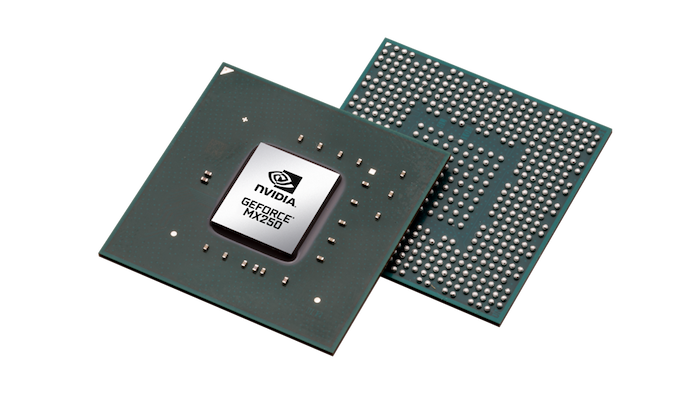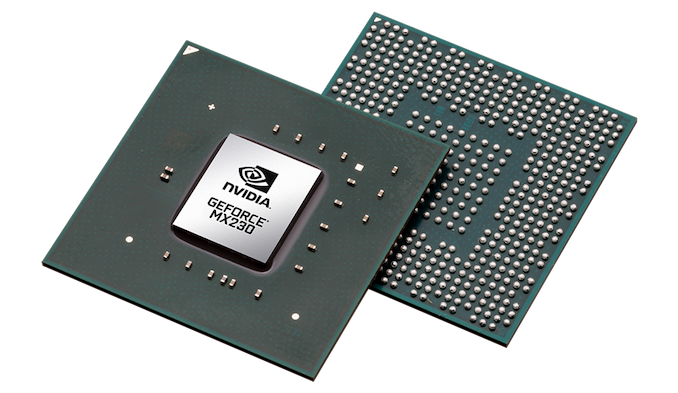NVIDIA Quietly Releases GeForce MX250 & MX230: Entry-Level Laptop GeForce
by Ryan Smith on February 21, 2019 11:00 AM EST
With the launch of their GeForce 20 Series parts already well underway, it was only a matter of time until NVIDIA updated their low-end parts as well, and that time has finally arrived. Quietly published on NVIDIA’s website this morning are the product pages for the GeForce MX250 and MX230 graphics processors. The entry-level members of NVIDIA’s laptop lineup, these Pascal parts will eventually replace the current GeForce MX110/130/150 parts.
As has annoyingly become tradition for NVIDIA, they’re officially saying very little about the new parts. The official specifications don’t include anything about clockspeeds, CUDA core counts, ROPs, etc. Instead, NVIDIA only confirms a basic set of features: both parts use GDDR5 memory, both feature GPU boost functionality, and both are based on the company’s Pascal architecture. Taking a stab in the dark here, these are almost certainly cut-down GP108 parts, similar to the previous MX150. So we’re looking at 384 (or fewer) CUDA cores at various frequencies, attached to GDDR5 over a 64-bit memory bus.
| Best Guess: NVIDIA Laptop Video Card Specification Comparison | ||||
| Typical MX250 | Typical MX230 | |||
| CUDA Cores | 384 | 384? | ||
| ROPs | 16 | 16? | ||
| Boost Clock | Variable | (Lower than MX250) | ||
| Memory Type | GDDR5 | GDDR5 | ||
| Memory Bus Width | 64-bit | 64-bit | ||
| VRAM | <=4GB | <=2GB | ||
| GPU | GP108 | GP108 | ||
| Manufacturing Process | Samsung 14nm | Samsung 14nm | ||
| Launch Date | 02/21/2019 | 02/21/2019 | ||
NVIDIA’s low-end parts have typically been half a generation or so behind their leading parts, so the MX250 and MX230 are no exception. Despite this, as the previous MX130 was based on Maxwell (GM108) and sometimes paired with DDR3, this is actually a big step up for these parts. Still, clockspeed is going to be everything here as far as performance goes, as these low-end parts tend to ship with a wide variety of clockspeeds depending on what a laptop manufacturer needs.
NVIDIA for its part does once again offer their “GeForce Performance Score”, but since these values are relative to a floating target – in this case the UHD 620 iGPU in Intel’s Whiskey Lake-U i5-8265U, the scores can’t be compared to past NVIDIA parts. Not that it matters for NVIDIA or its customers, as NVIDIA is competing with Intel’s iGPUs as a first-tier performance upgrade, not competing with their own past parts. In this case, NVIDIA is touting their parts as offering 2.6x and 3.5x the performance of the UHD 620 respectively.
Based on NVIDIA's previous release cadences for their low-end laptop parts, xpect to see these new processors show up in laptops in the very near future. Traditionally these parts are paired with Intel U-series processors, and I expect to see the same here.
Source: NVIDIA (via SH SOTN)











24 Comments
View All Comments
tipoo - Thursday, February 21, 2019 - link
If this is more or less standing still vs the MX150, I wonder how much Gen11 graphics can close the gap with it.Kevin G - Thursday, February 21, 2019 - link
The fact that Intel's Gen10 graphics is vaporware, that is probably the reason why nVidia has been able to procrastinate so long on the low end.I suspect that this particular move is an effort to capture some potential Cannon Lake combo sales (most are currently paired with low end Radeons) and Ryzens with their IGP gaining in popularity.
Flunk - Thursday, February 21, 2019 - link
Alll 3 "different" GPUs are powered by very slightly different versions of the GP108. Basically pointless in a notebook. Not powerful enough to be worth the power draw.danielfranklin - Thursday, February 21, 2019 - link
Thats basically true.IF a manufacture decided to wire the external outputs to the GPU instead of the Intel Graphics, then this would have a place.
Outside of playing 10 year old games, there is no performance increase in having these GPUs for any kind of desktop work, which is where the intel actually suffers.
I run many monitors off laptops and as everything always goes via the Intel and you cant witch it off, there are dropped frames, high latency and just bad performance across the board.
Funny enough, close the lid on the laptop, plus in an Nvidia 1030 in a Thunderbolt 3 box into the external monitors and performance is fantastic, no laggy latency issues.
Intel and manufactures are the problem and with it, make these GPUs pointless for 99% of all purposes.
neblogai - Sunday, February 24, 2019 - link
That is not true at all. These GPUs make basically all latest games playable at reduced resolution/settings, which is acceptable for many casual gamers, or gamers on the go. Integrated Intel graphics is several times weaker, and can run at decent fps only a fraction of games.OremLK - Thursday, February 21, 2019 - link
Looks *exactly* like a rebadged MX150. Bummer, I was hoping it'd be a real upgrade for some of these new ultrabooks.PeachNCream - Thursday, February 21, 2019 - link
It does, but hopefully NVIDIA isn't offering way to feed the GPU with DDR3 at this point. It seems like GDDR5 is now a requirement. If that's the case, it will at least address one problem with budget segment GPUs that has been haunting them for a number of years.mczak - Thursday, February 21, 2019 - link
Nvidia actually "fixed" the ddr3 problem with the MX150, which is always using gddr5. The same isn't true for the MX130 (this one is a maxwell rebrand in any case, not gp108), albeit nowadays it usually seems to ship with gddr5 too.PeachNCream - Friday, February 22, 2019 - link
Ah thank you for setting me straight on that one. I was getting the MX150 and MX130 mixed up a bit.MadManMark - Wednesday, February 27, 2019 - link
What leads you to believe that you can conclude performance from how it looks? And why don't you understand that manufacturing in exactly the same form factor as previous is actually better for notebook OEMs?